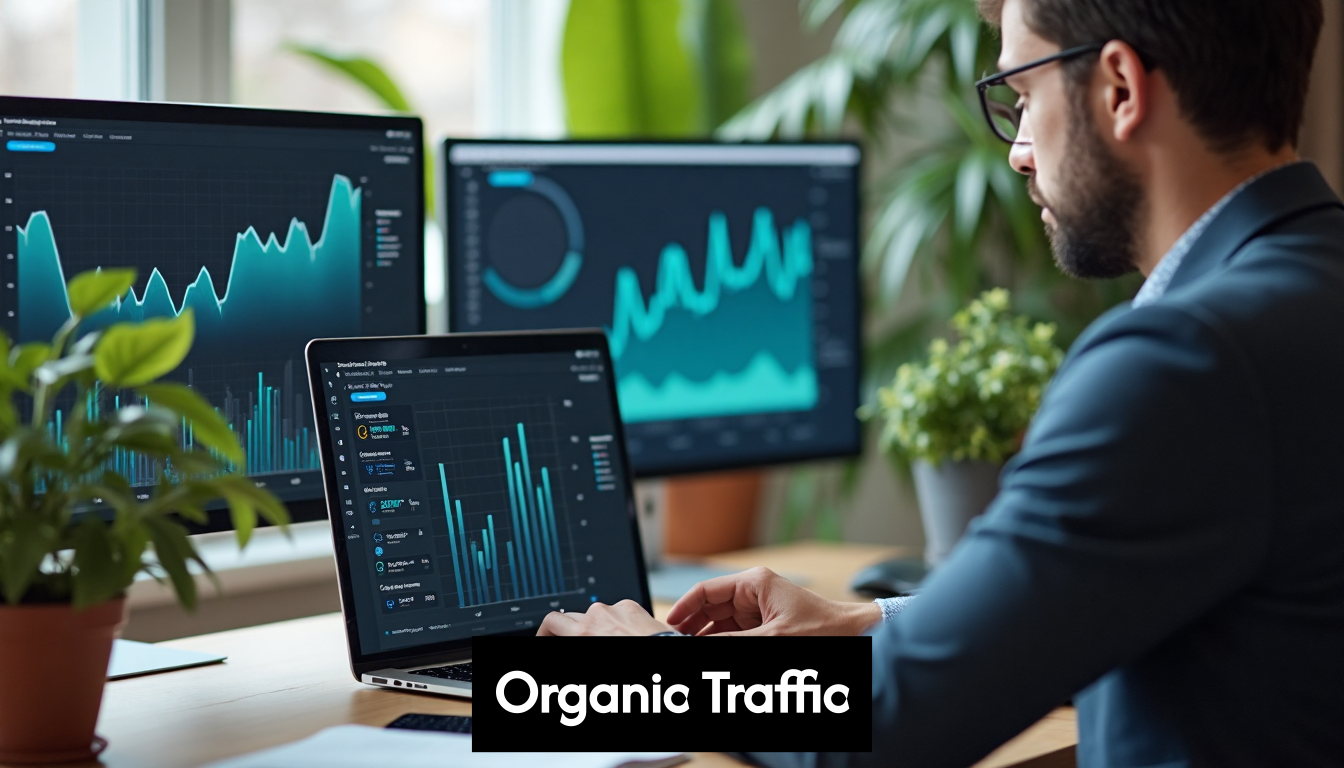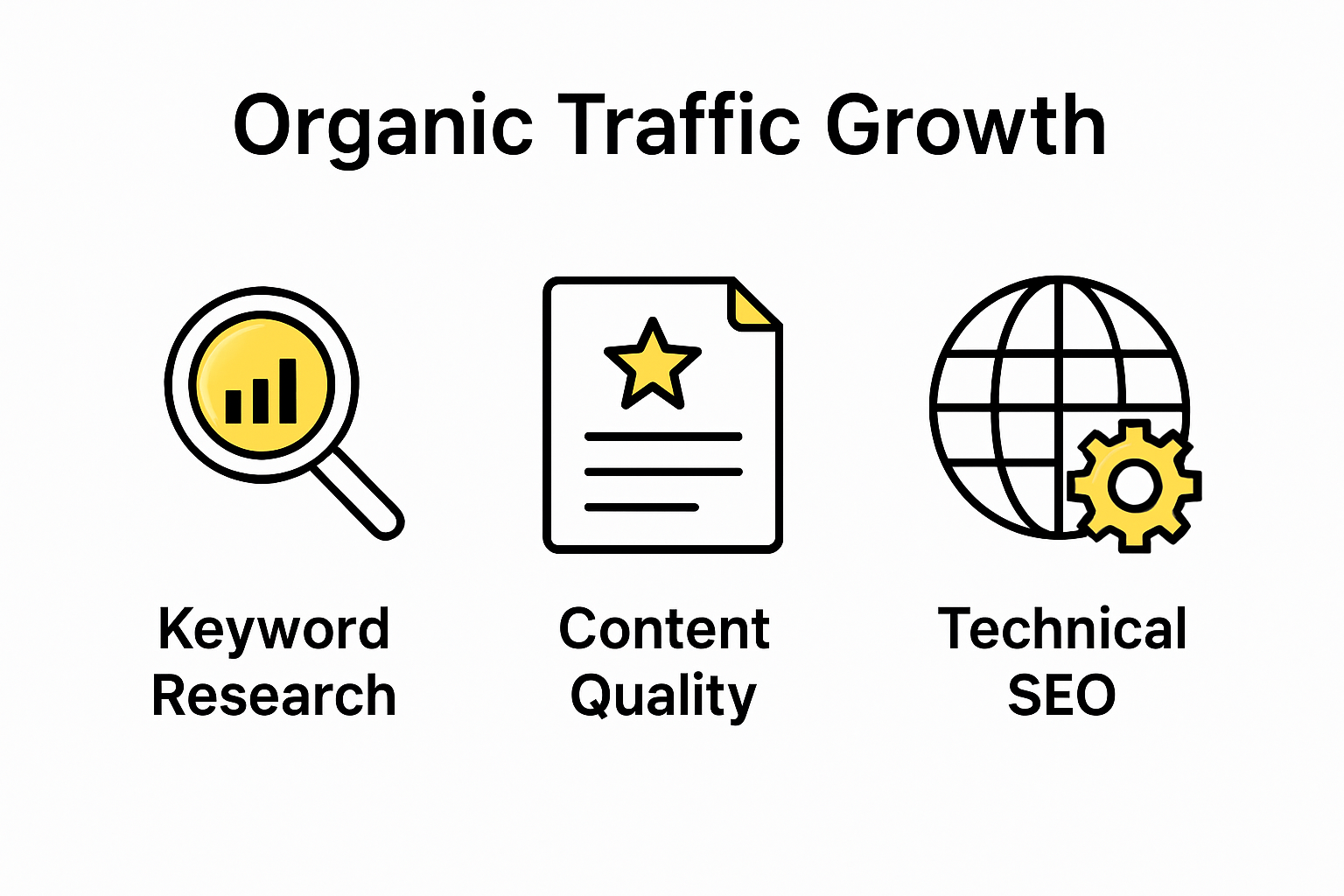Proven Strategies for Organic Traffic Growth in 2025


Organic traffic is still the backbone of digital visibility and credibility, yet in 2025 a wild statistic stands out. AI powered optimization now separates leaders from laggards, with machine learning driving content creation and traffic spikes no human team can match. You might think stuffing articles with keywords is the ticket to the top. Actually, sustainable growth depends on smart content strategies and technical excellence that search engines now demand.
Table of Contents
- Understanding The Foundations Of Organic Traffic Growth
- Essential SEO Tactics Driving Results In 2025
- Content Strategies To Sustain And Scale Organic Traffic
- Practical Ways To Measure And Optimize Your Traffic Gains
Quick Summary
| Takeaway | Explanation |
|---|---|
| Understanding Search Engine Mechanics | Marketers should grasp how search engines evaluate factors like content relevance and user experience to improve organic visibility through strategic keyword research and long tail keywords. |
| Prioritizing Quality Content | Consistently producing high-quality, original content that provides substantial value helps build authority and improves search rankings in organic traffic growth. |
| Implementing Technical SEO | Technical optimization, including speed, mobile responsiveness, and structured data markup, is crucial for ensuring efficient crawling and better user experience that impacts search rankings. |
| Leveraging AI for Optimization | Utilizing AI tools for content creation and optimization offers insights into user intent, potential ranking opportunities, and semantic keyword analysis, giving marketers a competitive edge. |
| Measuring and Optimizing Effectively | Advanced performance measurement techniques and data-driven optimization strategies are essential for understanding traffic quality, enhancing user engagement, and anticipating trends for sustainable growth. |
Understanding the Foundations of Organic Traffic Growth
Organic traffic growth represents the cornerstone of sustainable digital marketing success. Unlike paid strategies that require continuous financial investment, organic traffic develops through strategic content creation, search engine optimization, and genuine audience engagement.
The Core Mechanics of Search Engine Visibility
Search engines like Google use complex algorithms to determine website rankings. These algorithms evaluate multiple factors including content relevance, user experience, website authority, and engagement metrics. Understanding these core mechanics helps marketers create targeted strategies for improving organic traffic.
Keywords play a critical role in organic visibility. Strategic keyword research allows content creators to identify precise search terms their target audience uses. This approach goes beyond simple matching - it requires deep comprehension of user intent and the specific questions potential visitors want answered.
For instance, long tail keywords often represent more specific search queries with lower competition. A long tail keyword like "best organic SEO strategies for small businesses" typically converts better than a generic term like "SEO" because it demonstrates more precise user intent.

Building Authority Through Quality Content
Content remains the primary driver of organic traffic growth. Search engines reward websites that consistently produce high quality, original content that provides genuine value to readers. This means creating comprehensive, well researched articles that thoroughly address user questions.
Successful content strategies involve:
- Depth of Information: Providing comprehensive insights beyond surface level explanations
- Original Research: Presenting unique data or perspectives
- Expert Perspective: Demonstrating genuine knowledge and credibility
Websites that regularly publish authoritative content signal to search engines that they are reliable information sources. This consistent signaling gradually improves domain authority and search rankings.
Technical Foundations of Organic Performance
Technical optimization supports organic traffic growth by ensuring search engines can efficiently crawl and understand website content. Key technical factors include website speed, mobile responsiveness, clean site architecture, and proper HTML structuring.
Implementing structured data markup helps search engines understand content context more precisely. This can lead to enhanced search result displays, potentially increasing click through rates. Google's Structured Data Guidelines provide comprehensive insights into implementing these technical optimizations.
Additionally, websites must prioritize user experience. Factors like page load speed, intuitive navigation, and mobile compatibility directly impact search rankings. Search engines increasingly use user interaction metrics as ranking signals, meaning websites that provide smooth, engaging experiences will naturally attract more organic traffic.
Organic traffic growth is not a quick fix but a strategic, long term approach to digital marketing. By understanding search engine mechanics, creating exceptional content, and maintaining strong technical foundations, businesses can develop sustainable online visibility that attracts genuine, interested visitors.
Essential SEO Tactics Driving Results in 2025
The digital marketing ecosystem continues to evolve rapidly, with SEO tactics becoming increasingly sophisticated and nuanced. Successful organic traffic growth in 2025 demands a multi dimensional approach that combines advanced technological understanding with strategic content development.
AI Powered Content Optimization
Artificial intelligence has transformed SEO strategy, enabling more precise and targeted content creation. Machine learning algorithms now help marketers understand user intent with unprecedented accuracy. These advanced systems analyze search patterns, user behavior, and content performance to provide actionable insights for optimization.
AI tools can now generate content outlines, suggest keyword variations, and predict potential ranking opportunities. OpenAI's Language Models demonstrate how sophisticated natural language processing can help identify content gaps and recommend strategic improvements. Marketers who leverage these technologies gain a significant competitive advantage in understanding and meeting user search expectations.
Key AI powered optimization strategies include:
- Semantic Keyword Analysis: Identifying related conceptual terms beyond exact match keywords
- Content Performance Prediction: Estimating potential ranking and engagement metrics before publication
- User Intent Mapping: Understanding the deeper motivations behind search queries
Advanced Technical SEO Approaches
Technical SEO has moved beyond basic website optimization. Modern strategies focus on creating holistic digital experiences that satisfy both user and search engine requirements. Page experience signals have become increasingly important, with metrics like Core Web Vitals determining search rankings.
Website architecture now requires a comprehensive approach. This includes:
- Mobile First Design: Ensuring seamless experiences across all device types
- Page Speed Optimization: Reducing load times through advanced compression techniques
- Structured Data Implementation: Using schema markup to provide clear content context
Evolving Content Strategy Frameworks
Content creation has transformed from keyword stuffing to developing comprehensive, user centric resources. The most effective SEO strategies now prioritize depth, expertise, and genuine value. This means creating content that thoroughly addresses user questions while providing unique insights.
Successful content frameworks in 2025 emphasize:
- Comprehensive Coverage: Creating in depth resources that explore topics from multiple angles
- Expert Validation: Incorporating research, data, and authoritative perspectives
- Interactive Elements: Using multimedia and dynamic content to enhance user engagement
Search engines increasingly reward content that demonstrates genuine expertise and provides substantial user value. This shift requires marketers to think beyond traditional SEO tactics and focus on creating truly meaningful digital experiences.
The future of organic traffic growth lies in understanding and anticipating user needs. By combining advanced technological tools, sophisticated content strategies, and a deep commitment to user experience, businesses can develop powerful SEO approaches that drive sustainable digital growth.
Content Strategies to Sustain and Scale Organic Traffic

Scaling organic traffic requires a strategic and systematic approach to content creation that goes beyond traditional publishing methods. Successful digital strategies in 2025 demand sophisticated content planning that integrates audience insights, search intent, and continuous performance optimization.
Developing a Comprehensive Content Ecosystem
Effective organic traffic growth hinges on creating an interconnected content ecosystem that provides comprehensive value to users. This approach involves developing content clusters that deeply explore topics from multiple perspectives, allowing websites to establish topical authority and improve search rankings.
Content clustering enables websites to create comprehensive resources that address user questions at various stages of their information journey. By developing interlinked content pieces that cover a topic thoroughly, marketers can create a robust knowledge base that attracts and retains audience attention.
Key elements of an effective content ecosystem include:
- Pillar Content: Creating comprehensive, in depth resources that serve as central reference points
- Supporting Content: Developing detailed articles that explore specific aspects of the main topic
- Contextual Interlinking: Connecting related content to enhance user navigation and search engine understanding
Strategic Content Production Frameworks
Content production in 2025 requires a data driven approach that balances creativity with strategic precision. Successful marketers leverage advanced analytics and user insights to develop content that precisely matches audience needs.
Google's Search Quality Evaluator Guidelines emphasize the importance of creating high quality, authoritative content. This means going beyond surface level information and providing genuine expertise that addresses user questions comprehensively.Effective content production strategies involve:
- Audience Persona Development: Creating detailed user profiles to guide content creation
- Search Intent Mapping: Analyzing the specific motivations behind user searches
- Continuous Performance Analysis: Regularly evaluating content performance and iterating based on insights
Emerging Content Distribution Channels
Organic traffic growth now requires a multi channel approach that extends beyond traditional search engine optimization. Marketers must explore emerging platforms and distribution methods to reach audiences effectively.
Research from Content Marketing Institute highlights the growing importance of diversified content distribution. This includes leveraging platforms like podcasts, video content, and emerging social media channels to expand audience reach.Strategic content distribution involves:
- Platform Diversity: Creating content optimized for multiple channels
- Repurposing Content: Transforming core content into various formats
- Community Engagement: Building interactive experiences that encourage audience participation
Successful organic traffic growth requires a holistic approach that combines strategic content creation, advanced distribution techniques, and continuous optimization. By developing a comprehensive content strategy that prioritizes user value and leverages emerging technologies, businesses can create sustainable organic traffic growth that adapts to the evolving digital landscape.
The future of organic traffic lies in creating genuine, valuable content experiences that truly meet user needs. This demands a commitment to excellence, continuous learning, and a deep understanding of audience motivations.
Practical Ways to Measure and Optimize Your Traffic Gains
Measuring and optimizing organic traffic requires a strategic approach that goes beyond surface level analytics. Successful digital marketers understand that tracking performance is not just about numbers but about extracting meaningful insights that drive continuous improvement.
Advanced Performance Measurement Techniques
Modern organic traffic analysis demands sophisticated tracking methods that provide comprehensive insights into user behavior. Performance metrics now extend far beyond traditional pageviews and unique visitors, offering nuanced understanding of audience engagement and content effectiveness.
Google Analytics 4 provides advanced tracking capabilities that help marketers understand user journeys with unprecedented depth. Key performance indicators now include:- Engagement Rate: Measuring meaningful interactions beyond simple page loads
- Conversion Path Analysis: Understanding the complete user journey
- User Behavior Segmentation: Identifying specific audience group characteristics
Successful tracking involves looking beyond raw numbers to understand the quality of traffic. A website might have high visitor counts but low engagement, indicating a need for strategic content refinement.
Data Driven Optimization Strategies
Optimization requires a systematic approach to interpreting and acting on performance data. Marketers must develop agile strategies that allow rapid response to emerging trends and user behavior patterns.
Effective optimization techniques include:
- Continuous A/B Testing: Experimenting with content variations to improve performance
- User Experience Mapping: Identifying and eliminating friction points in content
- Performance Trend Analysis: Tracking long term content effectiveness
Predictive Analytics and Future Optimization
Advanced marketers are now leveraging predictive analytics to anticipate traffic trends and optimize content proactively. Machine learning algorithms can now predict potential content performance before publication, allowing for more strategic content development.
Predictive optimization strategies involve:
- Content Performance Forecasting: Estimating potential traffic and engagement
- User Intent Prediction: Anticipating emerging search behaviors
- Competitive Landscape Analysis: Understanding how content compares to industry benchmarks
The most successful organic traffic strategies combine historical data analysis with forward looking predictive techniques. This approach allows marketers to stay ahead of emerging trends and continuously refine their content strategies.
Optimizing organic traffic is an ongoing process of measurement, analysis, and strategic adaptation. By developing a comprehensive approach that combines advanced tracking, data driven insights, and predictive techniques, marketers can create sustainable traffic growth that adapts to the evolving digital ecosystem.
The key to success lies in maintaining a flexible, data informed approach that prioritizes genuine user value and continuous improvement. Marketers who view traffic optimization as a dynamic, iterative process will be best positioned to achieve long term digital success.
Frequently Asked Questions
What are the best strategies for increasing organic traffic in 2025?
To increase organic traffic in 2025, focus on creating high-quality content that meets user intent, implementing advanced technical SEO practices, leveraging AI for content optimization, and developing a comprehensive content ecosystem that interlinks topics.
How does AI impact organic traffic growth?
AI greatly impacts organic traffic growth by enabling precise content optimization and providing insights into user intent, engagement metrics, and potential ranking opportunities, allowing marketers to create more targeted strategies.
Why is technical SEO important for organic traffic?
Technical SEO is crucial for organic traffic as it ensures that search engines can efficiently crawl and index your website, improving user experience through faster load times, mobile responsiveness, and structured data implementation, which ultimately enhances search rankings.
How can I measure the success of my organic traffic strategies?
You can measure the success of your organic traffic strategies by analyzing key performance indicators such as engagement rates, conversion paths, and user behavior segmentation using tools like Google Analytics 4 and Search Console, allowing for data-driven optimization.
Ready to Transform Your Organic Growth Strategy?
Are you feeling the pressure to beat competitors with smarter, faster content and AI-driven tactics? In this article, you saw how AI-powered SEO and holistic content ecosystems are now the standard for driving organic traffic in 2025. If building authority, optimizing content, and scaling your reach are at the top of your list, you do not have to keep juggling manual processes and guesswork.

Let Babylove Growth give you an all-in-one edge. Tap into real-time research, automated blog creation, and structured content plans that reflect the strategies proven in this article. Watch step-by-step video guides, launch AI-optimized blog posts, and swap backlinks without expensive traditional tools. It is time to make organic growth your superpower. Start your smarter SEO journey today at Babylove Growth and be the first to outrank old-school competitors.
Smart SEO,
Faster Growth!
Most Read Articles

Generative Engine Optimization (GEO)
Learn how Generative Engine Optimization (GEO) helps your content rank in AI search engines like ChatGPT and Google AI. This comprehensive guide explains the differences between SEO and GEO, why it matters for your business, and practical steps to implement GEO strategies for better visibility in AI-generated responses.

Track LLM Traffic in Google Analytics 4 (GA4)
Learn how to track and analyze traffic from AI sources like ChatGPT, Claude, Perplexity, and Google Gemini in Google Analytics 4. This step-by-step guide shows you how to set up custom filters to monitor AI-driven traffic and make data-driven decisions for your content strategy.

How to Humanize AI Text with Instructions
Learn practical techniques to make AI-generated content sound more natural and human. This guide covers active voice, direct addressing, concise writing, and other proven strategies to transform robotic text into engaging content.

Open AI Revenue and Statistics (2024)
Comprehensive analysis of OpenAI financial performance, user engagement, and market position in 2023. Discover key statistics including $20B valuation, $1B projected revenue, and 100M+ monthly active users.